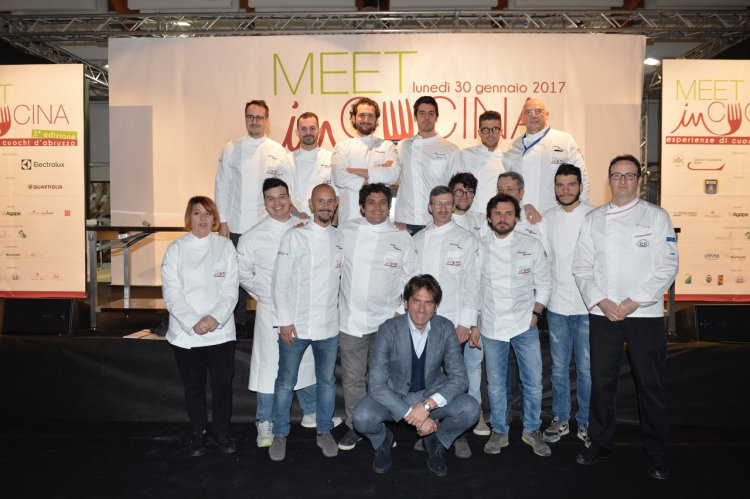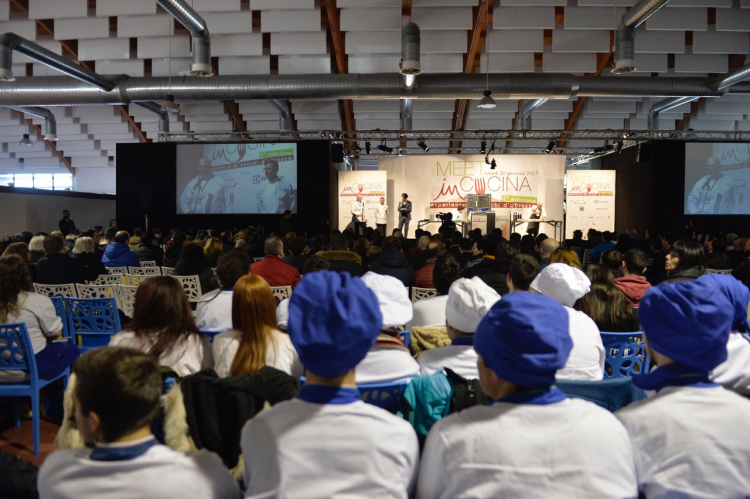Hands shaking, smiles, selfie requests: Romito is thrilled. Nearby, there are also Enrico Crippa and Mauro Colagreco, but he’s the superstar and rightly so: after all, we’re in Chieti, he’s playing at home, he’s the celebrity of Abruzzo. Catering students surround him, he’s ecstatic: «It’s fantastic!». He has sewn well and now gathers the deserved fruits, I think: «My students at Niko Romito Formazione are also giving me plenty of satisfaction. Many are opening their own restaurants, even in the surroundings» and he lists those who opened in Pescara, and those who are about to do so in Avezzano or who knows where...
I say: chef, they’re all your children, workwise; you could roll out a map of those who now have their restaurant, don’t you think? «No no, it’s too soon, I’d look old» he jokes [for the record, here’s a later episode they told us, but it’s too tasty to leave it sleeping in a notebook. Two young men approach Niko: «Can we take a picture with you?». And he, friendly as always: «Of course». They say: «Thank you! We’re also friends on Facebook! You’re Gianni Dezio, right?». He let it slide).

The chefs at Meet in Cucina. Romito is the only one missing
I write this to explain how Abruzzo is growing and growing in terms of food, so much so that sometimes new entries steal part of the stage from the bigger chefs. An almost beardless generation is eager to start, but without pushing, thanks to a devotion for those paving the way. The above mentioned
Dezio, for instance, attended
Niko Romito Formazione, and is fully part of the new generation that has returned home: young talents, originally from Abruzzo, who decided to return home after spending time abroad. He left the family restaurant in Venezuela,
Daniele D’Alberto came back from England,
Cinzia Mancini from France. They even acquired significant experience with our best chefs (
D’Alberto:
Vissani and
Cedroni.
Mancini:
Valeria Piccini… and so on). Now their restaurants in Abruzzo are making the most of the techniques learnt everywhere, applied to the extraordinary local products. Beautiful stories, which
Massimo Di Cintio concentrated without exceeding whatsoever in the third edition of
Meet in Cucina, the festival that took place this week, dedicated to the food of this (un)lucky land.
Meet in Cucina successfully represented a nice growth, in three steps, as illustrated in the invitation flyer. It showed the faces of the featured chefs, in different sizes: the masters where larger, and on top – Crippa, Colagreco, and king Romito in the middle. “Beginners” were below, we’ve already mentioned them: D’Alberto (Br1 in Montesilvano), Dezio (Tosto in Atri) and Mancini (Bottega Culinaria Biologica in S. Vito Chietino). Finally those who are part of a special group, very significant in this area, and all over Italy, were given an intermediate position and size: the family stories. Di Cintio chose two: Spadone, Mattia and Marcello, at La Bandiera in Civitella Casanova, and Tinari, Arcangelo and Peppino, at Villa Maiella in Guardiagrele. Both cases feature a father-son succession.
The participation of
Crippa and
Colagreco was not by chance. Like last year
Meet in Cucina was immediately sold out thanks to the arrival of
Massimo Bottura, who was not an intruder as his sous
Davide Di Fabio is from Abruzzo (this time, a very affectionate video arrived from
Osteria Francescana which ended with “Forza Abruzzo!!!” screamed at the top of the lungs), and in the same way even
Antonio Zaccardi is from Abruzzo – from Castiglione Messer Marino. He’s the sous working with the chef from Brianza in
Piazza Duomo: «We’re both quiet people. But I’m happy because
Enrico and I understand each other immediately without uttering a word. And in the end, we communicate through food». For
Colagreco the link with this region is twofold. First, because
Luca Mattioli was born in 1989 in Francavilla al Mare and since last June is the strong point at
Mirazur after acquiring experience in
Villa Maiella and at
The Waterside Inn with
Michel Roux. Second, for family reasons. The Argentinian chef, number 6 in the world in Mentone, has a Neapolitan grandfather and Calabrian grandmother on his mother’s side. On his father’s side, his grandmother is Basque from Bilbao while his grandfather
Oreste, is the son of
Luigi Colagreco who left Guardiagrele with a cardboard suitcase before the First World War exploded.
It was the first time the chef from Mirazur visited the area, «my family was poor, my grandfather was a teenager when his father died, so he lost every contact with his homeland». So when Mauro left Argentina for his adventure in Europe, also without a cent – in 2000 – he chose France instead of Italy, because he had some connections there, but not here in Italy. A lost chance. For us, of course.
Seeing Colagreco in “his” Guardiagrele, in that temple of food and hospitality that is Tinari’s Villa Maiella, was a nice sight. He listened with fascination to the tales of patron Peppino on the recovered black pig, a real trademark for the family. Or even to the Spadone family, on stage during the congress, as they praised the «fantastic local rooster, because we have people supplying us», and they then transform it into a delicacy, Gallo e granaglie, that is to say the bird then becomes food paired with what it used to eat.

Finally one should say that the pride and sense of belonging of the people from Abruzzo, who are strong by definition, were in fact made stronger by the recent sad news: they are tenacious people, they know hard work and don’t back down. So they look even more solid – today we’d say “they work as a team” – than many others; they seem to help each other (whether it’s just appearance or the truth, we’ll see) but most of all they create an important network with producers. They imagine dishes that, as the contemporary trend expects, are hymns to local produce; some even represent it visually, as with
Dezio’s
Terra di calanchi, a dessert that recalls the
calanchi in his hometown Atri: «I wondered what was edible in that ecosystem. I found many vegetal elements and this is how the recipe was born, I didn’t even know a cake would come out of it» (earth of liquorice, sorbet of beetroot, blackberries and raspberries, mousse of liquorice, sulla honey, powdered capers, wild fennel, mint, carrot sticks, oregano… This served on a plate made with clay from the
calanchi, with even creases to recall the place. Beautiful).
Eliodoro D’Orazio, regional president of Slow Food was also walking near the stands at Meet in Cucina: «Many young people return to agriculture. They’re mostly small producers who want to recuperate cultivation and turn over abandoned fields left in the exodus of the Seventies. There’s interest in their work and more and more restaurants choose them as suppliers. They’re the new keepers of an extraordinary biodiversity».
I ask him if there’s a product or story that’s particularly dear to him. He apologises: «There are many. It would be wrong for the others». Then he says: «Fagiolo di Frattura, it’s a bean from a village destroyed by the 1915 earthquake in Avezzano. It now belongs to the town of Scanno, on Gran Sasso» the same where the great shepherd and cheese maker Gregorio Rotolo, Bio Agriturismo Valle Scannese, makes heroic pecorino and caciocavallo currently travelling to my home in Milan. But let’s return to the beans: «They only grow there. They’re unique. They were disappearing, now there are small harvests, only 80 kg per year, but they sell like hot cakes», thanks also to some young people. D’Orazio thus depicts them, with rough brushes full of pure, stubborn Abruzzo: «They’re four tough guys who set their minds on producing these beans», is there anything to add to that?